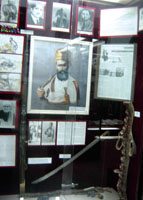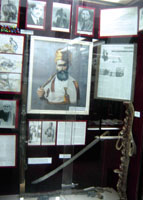
The Military Museum (Part 2 of a series)Yemen’s great history and heritage [Archives:2007/1051/Last Page]
May 17 2007
 |
fatimafnfr@yahoo.com
Journeying through Yemen's Military Museum in Sana'a, this series of articles will provide a general view of Yemeni civilization from both national and military history. This series will be published gradually, according to the order of the museums' halls.
His photograph is here depicting his strength and there are some marks on his face, as he appears to have fought a strong enemy. There is a story says that he fought a lion and he could kill it alone, Ali Nasser Al-Qardi is the man who killed Imam Yahya Hamid Al-Din.
When a group of Yemeni freedom fighters who were against the Imam's rule gave up all hope of convincing Imam Yahya to respond to the people's demands and when he refused to reform the nation's state of affairs, they prepared a plan to assassinate him and his heir apparent in Taiz.
On Feb. 17 1948, while Imam Yahya was inspecting some of his farms in the Hizyaz region, he was followed by a group of assassins composed of Al-Qardi and Qayid Al-Husseini with helping of other strugglers. While returning from his farms, they showered his car with a hail of bullets and killed him. For more information about the history of the 1948 Revolution, visit the third hall of Yemen's Military Museum in Sana'a.
The Mutawakilah Kingdom
Al-Mutawakilah Kingdom is located in the museum's second hall. Known as the age of Imam Yahya, who ruled Yemen after the Ottomans departed, this period witnessed the first revolution against him in 1948. Although it failed, it was the spark for Yemenis' freedom. During this revolution, many great martyrs gave their lives for Yemeni independence and now are symbols of historical Yemeni heroes.
The middle of the hall features a display of the first Yemeni aeronautics expedition to Italy. Additionally, there are several special war veterans displaying Turkish Age weapons acquisitions they left to support Imam Yahya. Such weapons are very heavy and difficult for a man to carry.
The 1948 Revolution Hall
Displayed in a corner of the third hall are numerous types of shackles used to manacle prisoners during the Imamate period. The heavy ones were used for Yemeni freedom fighters who were put in jails. The chains displayed here are from the Hajjah governorate jail where prisoners were sent.
Additionally, this hall contains a photograph of a sword, but it's not a normal one; rather, it's an important historical tool whose importance lies in its use, as it was used to execute Yemeni freedom fighters following the 1948 Revolution.
The 1955 Revolution Hall
Taiz governorate was the capital of Yemen during the period of Imam Ahmad Hamid Al-Din. In March 1955, Imam Yahya's son Ahmad was forced to abdicate in favor of his brother Abdullah by signing an abdication document.
However, he successfully tipped the scales to his favor by inciting within the garrison of Al-Qahira Castle of Taiz. He then succeeded in redirecting gunfire from the castle toward the Yemeni strugglers. A large war veteran's display is located in the fourth hall regarding the 1955 Revolution depicting the moment of executing the main leaders and characters in the revolution.
——
[archive-e:1051-v:15-y:2007-d:2007-05-17-p:lastpage]


